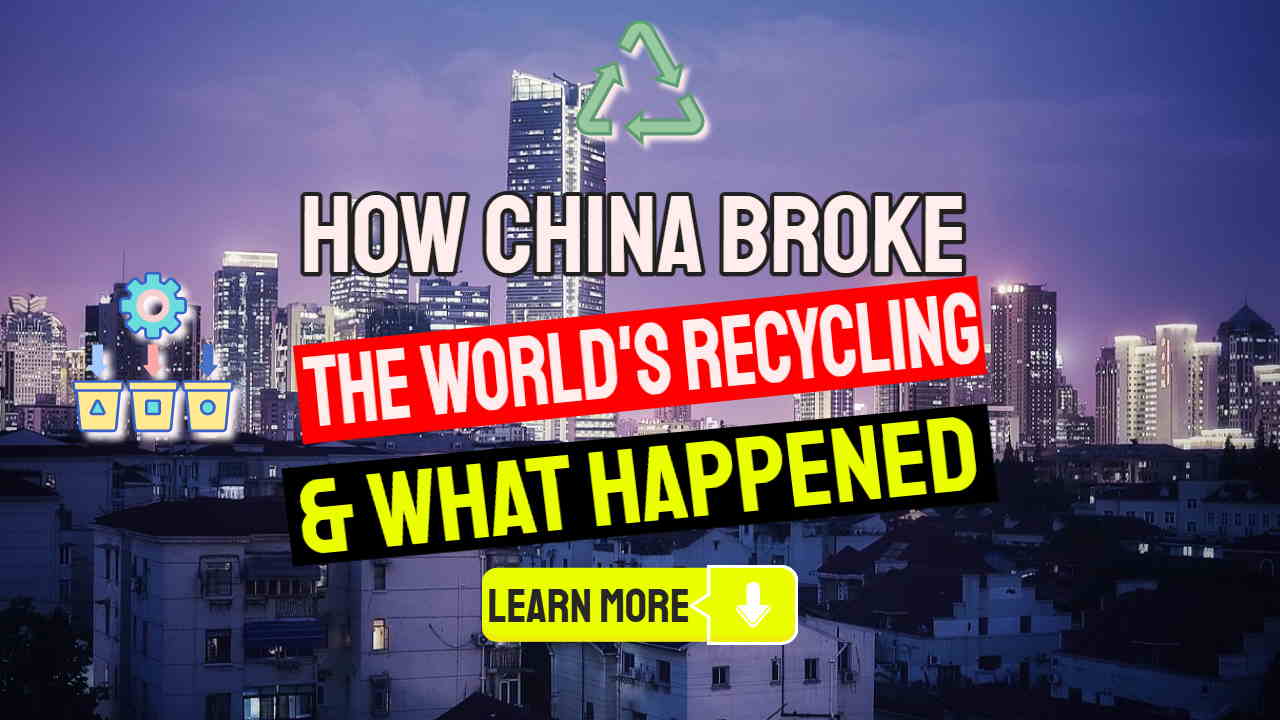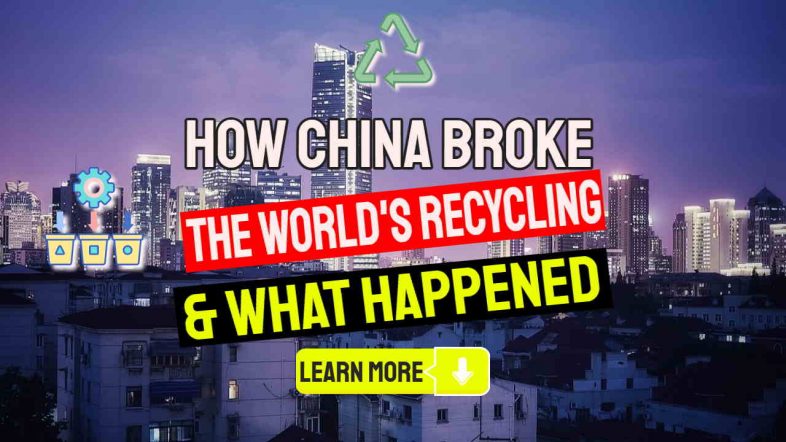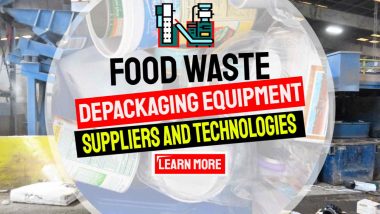On This Page:
- Plastic Piles Up in Wake of China Recycling Ban
- China Bans Plastic Waste
- How Plastic Recycling Used to Work Before the China Ban
- Low-Value Plastics Uneconomic for Recycling
- China Wakes Up to the True Cost of Plastic Waste
- Changes in plastic waste trade flow pattern subsequent to the China ban
- China to ban all imports of solid waste from 2021
- We’ll need to find somewhere else to recycle our plastic
- China Officially Enacting a Plastic Waste Import Ban – Conclusion
Plastic Piled Up in Wake of China Recycling Ban
China’s 2017 decision to stop accepting plastic waste from other countries caused waste plastic to stockpile around the globe. China issued a two-page document as a notification to the World Trade Organization committee on technical barriers to trade that changed the recycling world.
It was what’s referred to as a notification to the World Trade Organization committee on technical barriers to trade.
This particular notification although submitted on July 18, 2017, managed to send the entire global recycling industry into a tailspin or possibly even a death spiral.
Put simply, this document broke the world’s recycling system and now, in 2022, it is only starting to recover.
China Bans Plastic Waste
The National Development and Reform Commission (NRDC), China’s highest planning agency, declared in January 2017 that it was considering more measures to decrease plastic trash pollution. It promised stringent and specific rules on plastic products, as well as more prohibitions and a faster transition to less harmful materials.
After decades of being the world’s garbage dump, China ceased importing practically all plastic waste from other countries on January 1, 2018. Two years later, the country increased its efforts to reduce plastic pollution by declaring prohibitions on a variety of single-use plastics.
According to Reuters, the bans will “only resolve the most apparent types of plastic pollution,” according to Wang wang, chairman of the China Scrap Plastic Association. He said that they were simply one aspect of the country’s waste-reduction efforts. China’s national development and reform commission released a five-year waste reduction programme in January.

How Plastic Recycling Used to Work Before the China Ban
Here’s how it worked throughout the wealthier nations of the west before that 2-page banning document we described earlier. Take, for example, a single serving chicken noodle pot. The noodles are packaged in a thin polypropylene plastic container. And when it’s finished, you or I dispose of it in our recycling bin.
It is then picked up by a recycling truck a few days later and brought to the local recycling company’s Materials Recovery Facility (MRF). There, this container along with all the rest of the single-use plastic recycling picked up that day goes through a semi-automated sorting system.
Some products are simple to isolate. Most metals, for example, can be picked up by magnets, while paper and cardboard can be easily sorted by density, as they’re typically lighter than other recyclables.
Glass plastics and non-magnetic metals are a little more difficult to sort but each looks quite distinct. So optical scanners operate air-jet ballistic sorting equipment or other diversion tools that can sort these out. With a few more steps the facility produces a waste output stream which is more or less just plastic. All good so far, but that’s where things get difficult.
Plastic comes in all sorts of shapes, sizes and types, and different shapes, sizes or types of plastic are recycled in different ways. Optical sensors in the ballistic separators start out by at least accomplishing high-level filtering though.
For example, in many US states, plastic bottles are sold with a five or 10 cents deposit, meaning that recycling companies put a lot of effort into recovering those from the mix, as they can be sold for an income, at least these are more valuable relative to other plastics.
They also put a lot of work into recovering certain plastic types such as high-density polyethylene (HDPE), as both can be sold for more and are easier to separate out of the mix. HDPE is typically used to make larger items like plastic crates, shampoo bottles, and other products where sturdiness is paramount and some impurities in the resin matter less.
So, the polyethylene and other higher-value plastics were then, and still are, quite accurately sorted and then melted down into bulk raw plastic, for resale to manufacturers. Most other plastics though have a negative value, they can’t be sold.
And in fact, it would take so much work to turn them into usable raw material that it was, even before the China ban, not economically viable to do so. Hence, recycling companies had to pay someone to take it off their hands.
Low-Value Plastics Uneconomic for Recycling
Smaller items like bottle caps, plastic bags, and other scraps under three inches or eight centimetres in width that cannot be easily sorted by automated systems fell into this category.
These are then aggregated and, at best, used to generate electricity through incineration, and at worst, simply disposed of in a landfill.
To summarise, some high-value plastic is recovered immediately, while negative-value plastic is either incinerated (as SRF or RDF) or, if too dirty, disposed of in a landfill.
Then there’s a third category in the middle. That’s when things start to get interesting. Anything that isn’t small and unrecoverable or large and valuable is typically mixed and formed into large bales of unsorted medium size, medium value plastic that has a neutral or negative free market value.
The raw materials in these bales, known as “MRF residuals,” which are often referred to as or RDF but are not always clean enough for incineration, were shipped to China. Even in good times, the value of these MRF residuals was insufficient to cover the cost of the sorting process required for recycling in the west. As a result, they have no value, at least in the wealthier Western nations.
If properly sorted, the chicken noodles container you discarded would end up in one of these MRF residual bales bound for China. Shipping to China was nearly free in otherwise empty containers returning to China with new loads of consumer goods.
In China, a low-wage, uneducated workforce was available to hand sort the bales. Although some value was obtained for the resulting plastic, much of it simply went to poorly regulated and low-cost Chinese landfills or was illegally dumped.
China Wakes Up to the True Cost of Plastic Waste
Prior to 2017, China had been becoming more prosperous for over 30 years, and wages had risen to the point where hand recycling no longer provided a profit. It was unavoidable that waste acceptance would become unprofitable for China at some point. The final straw came when Chinese authorities raised their environmental standards, requiring illegal dumping to be funded from public funds.
For example, one of three plastics that are extremely difficult to recycle in curbside recycling programmes is polyvinyl chloride (PVC or vinyl). It has also been deemed unsafe due to the release of phthalates, which may be harmful to human health. PVC can be found in a wide range of household products, including backpacks, shoes, window frames, flooring, appliances, credit cards, shampoo bottles, and many others. PVC is commonly used in the manufacture of plastic wrap. To make matters worse, PVC is frequently used in conjunction with other plastics, making plastic separation by type even more difficult.
In retrospect, China’s ban was unavoidable, but unlike democratic governments, the ruling party was not constrained by commercial concerns. The need for businesses to recoup their investments before implementing changes usually results in years of forewarning.
However, no such restraint exists for the Communist Party-led Chinese administration, allowing for the rapid implementation of the ban, which was far too quickly implemented for the West to adjust to.
Changes in the Plastic Waste Trade Flow Pattern Subsequent to the China Ban
Prior to China’s plastic waste ban in 2017, there had been a trend of increasing plastic waste shipments from developed to developing countries every year since the late 1990s.
When China announced an unprecedented ban on the import of most plastic waste in 2017, the global plastic waste trade flow plummeted. The necessary changes in exporting countries’ waste treatment infrastructure that allow them to sort these plastics in the source countries are only now (in 2022) beginning to have a real impact on stemming the trade in plastic waste transhipment.
Since 2018, a number of low-wage countries have increased their imports of MRF residuals, or low-quality RDF (Refuse Derived Fuel). However, a rising tide of plastics, fueled in part by a lack of plastic recycling in developing countries and an increase in waste plastic export to countries such as Malaysia, India, and Indonesia, is now posing a major environmental threat, polluting land and depleting marine life.
The consequences for global environmental sustainability are enormous, and many have yet to be thoroughly scientifically investigated.
To quantify the environmental impacts of changes in the flow patterns and treatment methods of at least a half-dozen types of plastic waste in at least 18 countries accepting increasing tonnages of MRF residuals following the ban, global adoption of Life Cycle Assessment (LCA) methods is required.
In the short term, the ban significantly improved four midpoint environmental impact indicators, albeit contributing to global warming. However, governments in the West must do much more to process difficult-to-recycle plastics in their home countries.
China to Ban all Imports of Solid Waste from 2021
In response to the United States’ concerns, China has stated that it will “further adjust categories of waste imports,” but has no plans to lift the ban, according to the Chinese state-run Global Times.
According to Chinese customs data, the country’s imports of solid waste, which includes plastics, paper, and metal, fell by 54% in the first quarter of 2018 following the January ban.
The Chinese government’s ban on importing millions of tonnes of plastic waste starting in January 2021 could mean the end of some plastic collection in the UK.
According to industry insiders, it may also increase the risk of environmental pollution. Some recycling companies predicted that China would implement restrictions in 2021. They continue to pose significant challenges to the United Kingdom’s efforts to recycle more plastic.
Finding Somewhere Else to Recycle our Plastic
Waste management organisations around the world are collaborating to find solutions to plastic scrap waste stream problems. Their goal is to divert plastic waste away from costly, gas-emitting landfills. Scrap plastic is increasingly valuable enough that plastic recyclers can pay for it, effectively replacing an expense with revenue.
The imposition in April 2022 of a new UK tax on single-use plastic bottles and other items that do not contain at least 20% recycled plastic resin will benefit UK plastic recyclers. According to sources, the value of recycled plastic resin in the UK has tripled since January 2022. The UK is the first EU country to implement such a levy.
Plastic recycling has become easier and more cost-effective as recycling technologies have advanced. Such technologies include dependable detectors and sophisticated decision and recognition software, which together improve the productivity and accuracy of automatic plastic depackaging and sorting.
Another significant advancement in plastic recycling has been the discovery of higher-value applications for recycled polymers in closed-loop recycling processes. Since 2005, for example, PET sheets for thermoforming in the United Kingdom can contain up to 70% recycled PET when a/b/a layer sheets are used.
In 2018, more than 35 million tonnes of plastic were produced in the United States, with only 8.7% recycled. Some plastics are not accepted in municipal recycling programmes. Find out which types of plastic are accepted by your local recycling programme. Purchase products made from recycled plastic whenever possible.
China Is Officially Enacting a Plastic Waste Import Ban – Conclusion
Beginning in January 2018, China’s government imposed a plastic waste import ban in an effort to reduce the millions of tonnes of plastic and other recyclables it received each year.
This shift has had a significant impact on how the world recycles and disposes of plastic waste.
According to a Greenpeace analysis of customs data, British companies alone have imported over 2. 7 million tonnes of plastic waste into China and Hong Kong since 2012.
China accepted 51% of global plastic scrap imports in 2016, according to IndustryWeek. The majority of that trash came from the United States, where the majority of “recycled” plastics were and still are shipped abroad to be recycled.
The same is true in most other wealthy Western countries. As a result, trash has become one of the United States’ most important exports.





